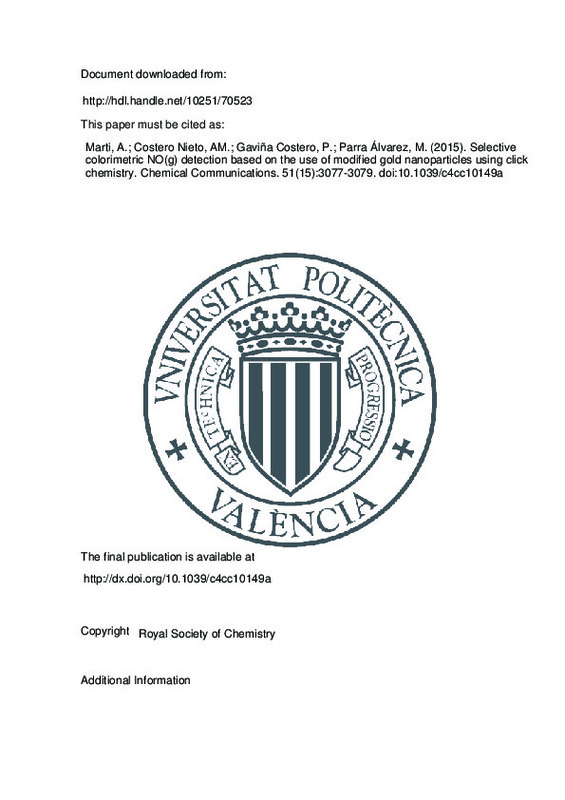Nagano, T. (1999). Practical methods for detection of nitric oxide. Luminescence, 14(6), 283-290. doi:10.1002/(sici)1522-7243(199911/12)14:6<283::aid-bio572>3.0.co;2-g
L. J. Ignarro , Nitric Oxide: Biology and Pathobiology, Academic Press, San Diego, 2010
Ma, S., Fang, D.-C., Ning, B., Li, M., He, L., & Gong, B. (2014). The rational design of a highly sensitive and selective fluorogenic probe for detecting nitric oxide. Chem. Commun., 50(49), 6475-6478. doi:10.1039/c4cc01142b
[+]
Nagano, T. (1999). Practical methods for detection of nitric oxide. Luminescence, 14(6), 283-290. doi:10.1002/(sici)1522-7243(199911/12)14:6<283::aid-bio572>3.0.co;2-g
L. J. Ignarro , Nitric Oxide: Biology and Pathobiology, Academic Press, San Diego, 2010
Ma, S., Fang, D.-C., Ning, B., Li, M., He, L., & Gong, B. (2014). The rational design of a highly sensitive and selective fluorogenic probe for detecting nitric oxide. Chem. Commun., 50(49), 6475-6478. doi:10.1039/c4cc01142b
Kojima, H., Nakatsubo, N., Kikuchi, K., Kawahara, S., Kirino, Y., Nagoshi, H., … Nagano, T. (1998). Detection and Imaging of Nitric Oxide with Novel Fluorescent Indicators: Diaminofluoresceins. Analytical Chemistry, 70(13), 2446-2453. doi:10.1021/ac9801723
Chen, X., Tian, X., Shin, I., & Yoon, J. (2011). Fluorescent and luminescent probes for detection of reactive oxygen and nitrogen species. Chemical Society Reviews, 40(9), 4783. doi:10.1039/c1cs15037e
Beltrán, A., Isabel Burguete, M., Abánades, D. R., Pérez-Sala, D., Luis, S. V., & Galindo, F. (2014). Turn-on fluorescent probes for nitric oxide sensing based on the ortho-hydroxyamino structure showing no interference with dehydroascorbic acid. Chemical Communications, 50(27), 3579. doi:10.1039/c3cc49555h
Lv, X., Wang, Y., Zhang, S., Liu, Y., Zhang, J., & Guo, W. (2014). A specific fluorescent probe for NO based on a new NO-binding group. Chem. Commun., 50(56), 7499-7502. doi:10.1039/c4cc03540b
Saha, K., Agasti, S. S., Kim, C., Li, X., & Rotello, V. M. (2012). Gold Nanoparticles in Chemical and Biological Sensing. Chemical Reviews, 112(5), 2739-2779. doi:10.1021/cr2001178
Mayer, K. M., & Hafner, J. H. (2011). Localized Surface Plasmon Resonance Sensors. Chemical Reviews, 111(6), 3828-3857. doi:10.1021/cr100313v
Martí, A., Costero, A. M., Gaviña, P., Gil, S., Parra, M., Brotons-Gisbert, M., & Sánchez-Royo, J. F. (2013). Functionalized Gold Nanoparticles as an Approach to the Direct Colorimetric Detection of DCNP Nerve Agent Simulant. European Journal of Organic Chemistry, 2013(22), 4770-4779. doi:10.1002/ejoc.201300339
Zhou, Y., Wang, S., Zhang, K., & Jiang, X. (2008). Visual Detection of Copper(II) by Azide- and Alkyne-Functionalized Gold Nanoparticles Using Click Chemistry. Angewandte Chemie International Edition, 47(39), 7454-7456. doi:10.1002/anie.200802317
Hua, C., Zhang, W. H., De Almeida, S. R. M., Ciampi, S., Gloria, D., Liu, G., … Gooding, J. J. (2012). A novel route to copper(ii) detection using ‘click’ chemistry-induced aggregation of gold nanoparticles. The Analyst, 137(1), 82-86. doi:10.1039/c1an15693d
Zhang, Y., Li, B., & Xu, C. (2010). Visual detection of ascorbic acid via alkyne–azide click reaction using gold nanoparticles as a colorimetric probe. The Analyst, 135(7), 1579. doi:10.1039/c0an00056f
Tran, D., & Ford, P. C. (1996). Nitric Oxide Reduction of the Copper(II) Complex Cu(dmp)22+(dmp = 2,9-Dimethyl-1,10-phenanthroline). Inorganic Chemistry, 35(9), 2411-2412. doi:10.1021/ic9511175
Tsuge, K., DeRosa, F., Lim, M. D., & Ford, P. C. (2004). Intramolecular Reductive Nitrosylation: Reaction of Nitric Oxide and a Copper(II) Complex of a Cyclam Derivative with Pendant Luminescent Chromophores. Journal of the American Chemical Society, 126(21), 6564-6565. doi:10.1021/ja049444b
Lim, M. H., & Lippard, S. J. (2005). Copper Complexes for Fluorescence-Based NO Detection in Aqueous Solution. Journal of the American Chemical Society, 127(35), 12170-12171. doi:10.1021/ja053150o
Apfel, U.-P., Buccella, D., Wilson, J. J., & Lippard, S. J. (2013). Detection of Nitric Oxide and Nitroxyl with Benzoresorufin-Based Fluorescent Sensors. Inorganic Chemistry, 52(6), 3285-3294. doi:10.1021/ic302793w
Haiss, W., Thanh, N. T. K., Aveyard, J., & Fernig, D. G. (2007). Determination of Size and Concentration of Gold Nanoparticles from UV−Vis Spectra. Analytical Chemistry, 79(11), 4215-4221. doi:10.1021/ac0702084
Lin, S.-Y., Tsai, Y.-T., Chen, C.-C., Lin, C.-M., & Chen, C. (2004). Two-Step Functionalization of Neutral and Positively Charged Thiols onto Citrate-Stabilized Au Nanoparticles. The Journal of Physical Chemistry B, 108(7), 2134-2139. doi:10.1021/jp036310w
Liu, X., Atwater, M., Wang, J., & Huo, Q. (2007). Extinction coefficient of gold nanoparticles with different sizes and different capping ligands. Colloids and Surfaces B: Biointerfaces, 58(1), 3-7. doi:10.1016/j.colsurfb.2006.08.005
Brotherton, W. S., Michaels, H. A., Simmons, J. T., Clark, R. J., Dalal, N. S., & Zhu, L. (2009). Apparent Copper(II)-Accelerated Azide−Alkyne Cycloaddition. Organic Letters, 11(21), 4954-4957. doi:10.1021/ol9021113
[-]







![[Cerrado]](/themes/UPV/images/candado.png)

